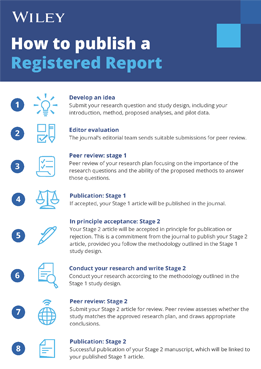Publish a Registered Report for an early peer review of your proposed research
What are Registered Reports?
Registered Reports enhance research transparency by allowing you to pre-register your study and have your proposed methods and analyses reviewed prior to conducting the actual research. This means that a significant part of your research is peer-reviewed and published before data collection is complete. This early feedback will result in an editorial decision based on the quality and importance of your research, instead of just the outcome.
Stage 1 peer review gives researchers "in principle acceptance" for their Stage 2 article before they begin their study. That in principle acceptance is based on peer review of the study methods, to assess the importance of the research question being asked and the quality of the methods chosen to address that research question. In principle acceptance is typically contingent on sufficient study power and quality control measures that ensure results are interpretable regardless of the primary outcome of the study.
Stage 2 peer review confirms that the researchers completed their study according to their "registered" Stage 1 study design, checks that any deviations from that design are appropriate and explained, and verifies that the results are reported completely and transparently.
What to include in your Stage 1 submission:
- Key research questions and background literature
- Hypotheses
- Experimental procedures
- Analysis pipeline
- Statistical power analysis (or Bayesian equivalent)
- Pilot data (if applicable)
Benefits of Registered Reports
Improved Planning and Research Design: Get feedback to refine your study design before you begin writing the hypotheses, defining the variables, and creating statistical tests
Enhanced Quality: Use early feedback to strengthen your work before conducting your study and writing your Stage 2 article
Recognition: Gain recognition for your research based on its quality and significance, not just the final outcome
How to publish a Registered Report

- Develop an idea
- Editor evaluation
- Peer review: Stage 1
- Publication: Stage 1
- In principle acceptance: Stage 2
- Conduct your research and write Stage 2
- Peer review: Stage 2
- Publication: Stage 2
Submit your research question and study design, including your introduction, method, proposed analyses, and pilot data.
The journal's editorial team sends suitable submissions for peer review.
Peer review of your research plan focusing on the importance of the research questions and the ability of the proposed methods to answer those questions.
If accepted, your Stage 1 article will be published in the journal.
Your Stage 2 article will be accepted in principle for publication or rejection. This is a commitment from the journal to publish your Stage 2 article, provided you follow the methodology outlined in the Stage 1 study design.
Conduct your research according to the methodology outlined in the Stage 1 study design.
Submit your Stage 2 article for review. Peer review assesses whether the study matches the approved research plan, and draws appropriate conclusions.
Successful publication of your Stage 2 manuscript, which will be linked to your published Stage 1 article.
Policy Recommendation: Journals publish Stage 1, preferably at the point of acceptance.
Wiley's policy is that journals publish Stage 1 Registered Reports after successful peer review, preferably at the point of acceptance. After Stage 1 publication, we would expect success in Stage 2 peer review to lead to two legitimate, linked articles about the same study.
The first article, after Stage 1 peer review, would register the study design publicly. It should be written in the future tense to increase clarity about the process. The second article, after Stage 2 peer review, would describe execution of that study. It may legitimately repeat or summarize methods described in the first article, while citing the Stage 1 protocol. It would, like any regular article, also present the study results, analysis, interpretation, limitations, conclusions, and so on per regular reporting guidelines. It would legitimately cite and be linked to the Stage 1 article.
This policy encourages consistency and transparency that is valuable for researchers and journals alike. Some benefits of publishing the Stage 1 article after successful Stage 1 peer review are that doing so:
- Gives researchers an incentive to progress to Stage 2 and publish their final results with the journal, no matter the outcome.
- Enables researchers to hold journals to their promise of an “in principle acceptance” irrespective of outcome, after successful Stage 2 peer review.
- Improves transparency around the provenance of ideas and establishes primacy of research methods and hypotheses prior to realizing results.
- Allows journals to lead change in positive directions for their communities by highlighting the innovative approach of registered reports.